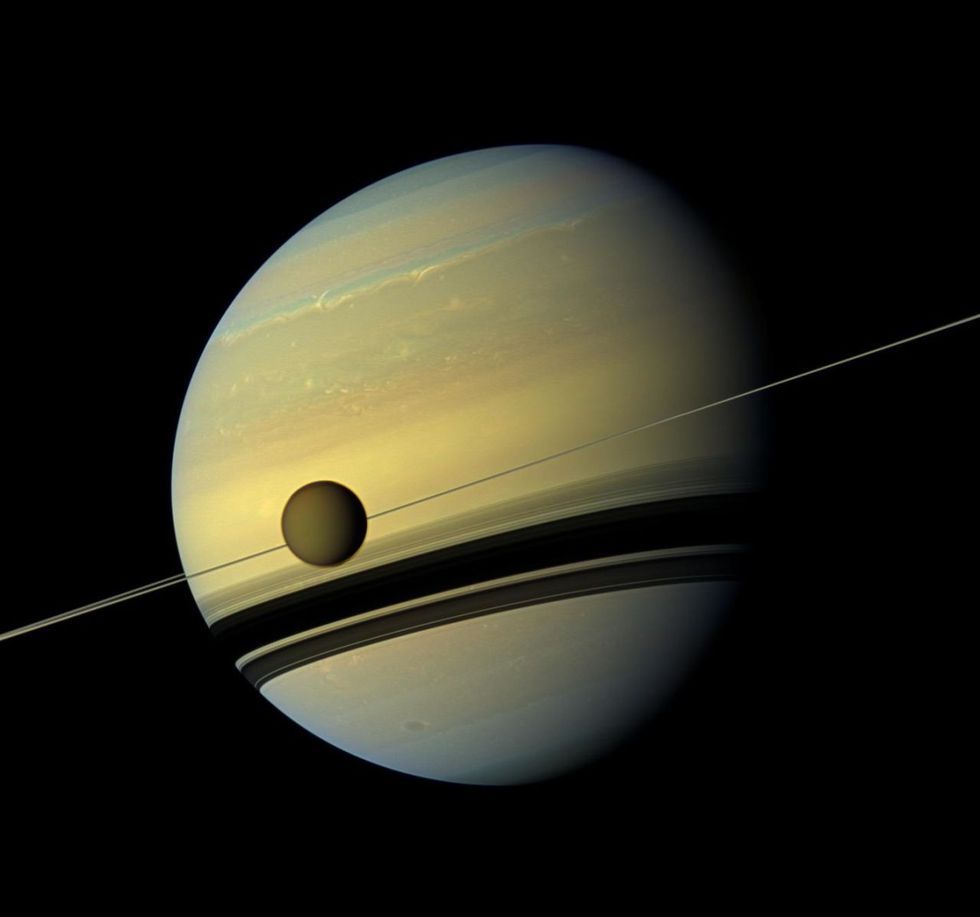NASA’s Dragonfly Mission Will Fly Through the Clouds of Titan, Saturn’s Biggest Moon
Over the course of its initial 2.7-year mission exploring Titan, the dual-quadcopter will fly a combined total of more than 108 miles
/https://tf-cmsv2-smithsonianmag-media.s3.amazonaws.com/filer/89/d9/89d9d087-b0ab-4338-86b2-07df1d9b535b/dragonfly-landing.png)
On Thursday, June 27, NASA announced the latest mission chosen for its interplanetary New Frontiers program: Come 2026, the space agency will launch a drone-like dual-quadcopter dubbed Dragonfly on a journey to Titan, Saturn’s largest moon. Titan is the only known world besides Earth with standing rivers, lakes and seas on its surface.
The expedition—the fourth to be funded under New Frontiers, which supports select planetary exploration projects with a price tag of less than $850 million—will use Titan’s dense atmosphere to its full advantage, sending the agile spacecraft flying across dozens of locations upon its arrival in 2034. In addition to exploring diverse locales, Dragonfly will simultaneously strive to identify large organic molecules conducive to creating the conditions necessary for life.
As Sarah Kaplan explains for the Washington Post, Titan boasts mountains of ice, liquid hydrocarbon-filled rivers and lakes, and a thick, nitrogen- and methane-rich atmosphere. If there’s any water to be found on the moon, it’s not on the surface; instead, scientists believe the liquid could be hiding beneath the celestial body’s frozen crust.
NASA is primarily interested in Titan because of its similarities to our own planet, Shannon Stirone reports for Scientific American. The moon, which is larger then the planet Mercury, could look a bit like an early version of Earth. Essentially, she writes, the mammoth moon “amounts to a planet-scale time machine and origins-of-life chemistry lab.”
“We know Titan has all of the ingredients necessary for life. How far does chemistry get in an environment that has all of the ingredients sitting there?” as Dragonfly’s principal investigator, Elizabeth Turtle of the Johns Hopkins University Applied Physics Laboratory, tells Stirone.
The Dragonfly mission will begin in Titan’s “Shangri-La” dune fields, which NASA notes are terrestrially similar to Namibia’s sand dunes. Per Wired’s Daniel Oberhaus, the Dragonfly craft will use eight rotors to propel itself on short flights once every 16 Earth days. These journeys—covering distances of up to five miles at speeds of around 20 miles per hour—will be powered by heat released by decaying plutonium-238 in a radioisotope thermoelectric generator (RTG), according to Vox’s Brian Resnick.
As George Dvorsky of Gizmodo points out, Dragonfly will be able to cover more territory in several days than rovers such as the Mars Curiosity could in years. Over the course of its initial 2.7-year mission through Titan's atmosphere, the aerial drone will fly a combined total of more than 108 miles.
In between these jaunts, Dragonfly—equipped with instruments including a mass spectrometer, gamma ray spectrometer, and a camera capable of snapping both microscopic and panoramic photographs—will conduct research tasks ranging from studying Titan’s atmospheric and geologic composition to probing for “conditions and chemicals relevant to biological processes,” as Oberhaus writes. It will also sample surface materials and measure underground seismic activity.

According to the Johns Hopkins APL Dragonfly portal, scientists first observed Titan via the two Voyager spacecraft in 1979 and 1980. Then, in 1994, the Hubble Space Telescope imaged the moon’s surface at near-infrared wavelengths, revealing the presence of mysterious bright and dark regions. The first in-depth exploration of Titan occurred in 2005, when NASA’s Cassini orbiter mapped the moon’s surface and deposited the Huygens probe, which is named after Dutch astronomer Christiaan Huygens, who discovered the Saturnian satellite in 1655. This spacecraft touched down on a plain that resembled a dry lake bed, achieving the first ever landing on a planetary body in the outer solar system.
The New York Times’ David W. Brown reports that Dragonfly was one of two missions in the running for the New Frontiers funding. The competition, which Brown likens to a “‘Shark Tank’ for deep space exploration,” winnowed down its field to two players in December 2017. Ultimately, Dragonfly emerged victorious over the CAESAR mission (short for Comet Astrobiology Exploration SAmple Return), a Cornell University project that aimed to collect samples from the comet 67P/Churyumov-Gerasimenko.
“Titan is an incredibly unique opportunity scientifically,” Turtle concluded in an April interview with The New York Times. “Not only is it an ocean world—an icy satellite with a water ocean in its interior—but it is the only satellite with an atmosphere. And the atmosphere at Titan has methane in it, which leads to all sorts of rich organic chemistry happening at even the upper reaches of the atmosphere.”
/https://tf-cmsv2-smithsonianmag-media.s3.amazonaws.com/accounts/headshot/mellon.png)


/https://tf-cmsv2-smithsonianmag-media.s3.amazonaws.com/accounts/headshot/mellon.png)